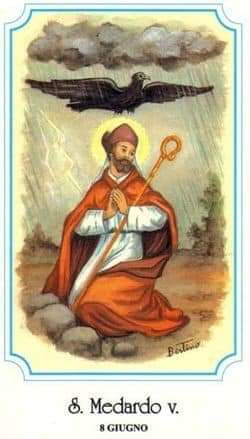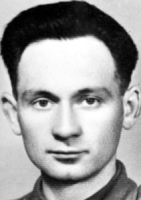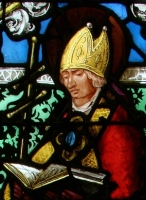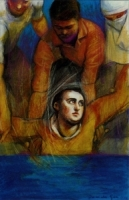St. Severinus
Feastday: June 8
Patron: of Pioraco
Death: 550
ictorinus. Severinus and Victorinus became hermits at Montenero, Italy, giving away their extensive wealth to the poor. Compelled to become bishops by Pope Vigilius, Severinus served as head of Septempeda (modern Sanseverino) in the marches, or territories of Aneona, and Victorinus was named bishop of Camerino.
Saints Severinus of Sanseverino (or of Septempeda) (d. 550 AD) and Victorinus of Camerino (d. 543 AD) were brothers who were both bishops and hermits of the 6th century.
Biography
According to an unreliable legend, the brothers were noblemen who had given away their great wealth to the poor and had become hermits at Monte Nero near Septempeda.[2]
Victorinus then withdrew to a cave near Pioraco.[3] Victorinus was prone to strong temptations, and he inflicted upon himself a difficult and painful penance: he had himself tied to a tree, with his hands clasped between two branches.[1] Victorinus’ particular method of self-mortification was depicted on a small panel in the church of San Venanzio, in Camerino, by the artist Niccolò da Foligno (called l'Alunno), who created the piece between 1478–80.[4]
However, in 540 Pope Vigilius appointed them each as bishops of two separate sees: Severinus became bishop of what was then called Septempeda, later called San Severino Marche after him, in the Marches of Ancona; Victorinus became bishop of Camerino.
Severinus died in 545. His remains were hidden in the Cathedral of St. Maria in Septempeda to protect them from looting; found in 590 during the restoration of the cathedral, they were brought to Monte Nero.
Veneration
There is a church dedicated to San Vittorino in Pioraco. Their joint feast day is June 8
St. Levan
Feastday: June 8
Death: 6th century
Celtic saint, sometimes listed as Levin or Selyr. He went to Cornwall, England, as a missionary and is revered there
6th century. The Irish Saint Levan (possibly a shortened form of Silvanus) migrated to Cornwall, where he gave his name to a parish (Benedictines).
Saint Medard of Noyon
புனித.மேடர்டாஸ் (St. Medardaus)
ஆயர்
பிறப்பு
475
வாலெண்சியென்னா(Valencienne), ஆப்பிரிக்கா
இறப்பு
560
பிரான்சு
இவர் தன் இளம் வயதில், ஒரு நாள் புல்வெளியில் நடந்து கொண்டிருக்கும்போது, இடி மின்னலுடன் கூடிய மழை வந்தது. அப்போது ஒரு பெரிய பருந்து வந்து இளைஞனை அப்படியே தூக்கிக்கொண்டு பிறந்தது. இளைஞன் மழையில் நனையாமல் இருக்க தன் சிறகுகளை அடர்ந்து விரித்து, தன் சிறகுகளின் நிழலில் வைத்து காத்தது. இதனால் மழை இல்லாமல் இயற்கை வளம் கருகும்போது இவரின் பெயரை கூறி ஜெபித்தால் மழை வரும் என்ற நம்பிக்கை பரவியது. அதேபோல் மக்கள் இவரின் பெயரால் ஜெபிக்கும்போது, பலமுறை மழையைபெற்று கொண்டனர். இதனால் ஜூன் 8 ஆம் நாள் மழைக்கான நாள் என்று குறிப்பிட்டுள்ளனர். இறைவனின் அருளால் நிரப்பப்பட்டு இவர் எப்போதும் சிரித்துக் கொண்டே இருப்பார். இவர் சிரித்தாலே, இவரின் வாயில் உள்ள மொத்தப் பற்களையும் பார்க்கலாம். அவ்வாறு அவர் வாய்விட்டு சிரிப்பார்.
505 ஆம் ஆண்டு இவர் குருவாக திருநிலைப்படுத்தப்பட்டார். 530 ஆம் ஆண்டு பாரிசிலிருந்த நையன் (Noyon) என்ற மறைமாநிலத்திற்கு ஆயராக தேர்ந்தெடுக்கப்பட்டார். இவர் ரைம்ஸ் (Reims) பேராயர் ரெமிஜியுஸ் என்பவரால் ஆயராக திருநிலைப்படுத்தப்பட்டார். ஆயர் மேடர்டாஸ் – ன்(Medardaus) பணி அம்மறைமாநிலத்தில் ஆல் போல் தழைத்து வளர்ந்தது. அப்போது அவர் தூரின் நாட்டு அரசின் ராடேகுண்டீஸ் என்பவரால் வதைக்கப்பட்டு கொல்லப்பட்டார். இவரது உடல் "புனித மடோனா" என்ற துறவற மடத்திற்கு சொந்தமான கல்லறையில் புதைக்கப்பட்டது. இன்று இக்கல்லறையின் மேல் ஒரு சிறிய கெபி கட்டப்பட்டுள்ளது
Also known as
Medardus
Profile
Son of Nectardus, a Frankish noble, and Protagia, Gallo-Roman nobility. Brother of Saint Gildardus, Bishop of Rouen, France. Pious youth and excellent student, educated at Saint-Quentin. Often accompanied his father on business to Vermand, France and to Tournai, Belgium, and frequented the schools there. Ordained at age 33.
Reluctant bishop of Vermand in 530; in 531, he moved his see to Noyon, France, which was further from border clashes. Bishop of Tournai in 532; the union of the two dioceses lasted until 1146. Gave the veil to Queen Saint Radegunde. Medardus was one of the most honoured bishops of his time, his memory has always been venerated in northern France, and he soon became the hero of numerous legends.
Each year on his memorial the Rosiere is awarded to the young girl who has been judged the most virtuous and exemplary in the region of Salency, France; she is escorted by 12 boys and 12 girls to the church, where she is crowned with roses and given a gift of money. This is a continuation of a yearly stipend or "scholarship" he apparently instituted when bishop.
Legend says that when he was a child, Medard was once sheltered from the rain by a hovering eagle. This is his most common depiction in art, and led to his patronage of good weather, against bad weather, for people who work the fields, etc. Legend has it that if it rains on his feast day, the next 40 days will be wet; if the weather is good, the next 40 will be fine as well. He was also depicted as laughing aloud with his mouth wide open; this led to his patronage against toothache.
Born
c.456 at Salency, Picardy, France
Died
• 8 June 545 at Noyon, France of natural causes
• relics at the royal manor of Crouy at the gates of Soissons, France
• a Benedictine abbey was built over his tomb
Patronage
• against bad weather
• against imprisonment, prisoners, captives
• against sterility
• against toothache
• brewers
• for good harvests
• for good weather
• for rain
• mentally ill people
• peasants
• vineyards
Representation
• being sheltered from rain by an eagle or other large bird
• holding a citadel
• laughing aloud with his mouth wide open
• leaving footprints in stone
• with two horses at his feet
Blessed Maria Droste zu Vischering
Also known as
• Countess Droste zu Vischering
• Maria Anna Johanna Franziska Theresia Antonia Huberta Droste zu Vischering
• Maria of the Sacred Heart
• Mary of the Divine Heart of Jesus
• Maria vom Göttlichen Herzen
Profile
Born to the wealthy German nobility, she had a twin brother, Max, and pious parents, Klemens Heidenreich Franz Hubertus Eusebius Maria, the count Droste zu Vischering, and Helene Clementine Maria Anna Sybille Huberta Antonia, the countess of Galen, who were loyal to the Church during the period of the Kulturkampf persecution. Baptized on the day of her birth, she grew up in Darfeld Castle, in Rosendahl, Germany, dressing like a princess and playing like a tomboy. She was educated at home by a governess and begining in April 1879 at the school of the Sacré-Coeur Sisters in Riedenburg, Bavaria, Germany. There she began feeling a call to religious life. She began her novitiate in the Congregation of Our Lady of Charity of the Good Shepherd at the convent in Münster, Germany on 21 November 1888; she received the habit on 10 January 1889, taking the name Maria vom Göttlichen Herzen (Mary of the Divine Heart). She became mother superior of the convent of the Sisters of the Good Shepherd in Porto, Portugal in 1896. Through her adult life she received visions and locutions from Jesus to promote devotion to the Sacred Heart of Jesus and the Blessed Eucharist. She influenced Pope Leo XIII to make the consecration of the world to the Sacred Heart.
Born
8 September 1863 in Münster, Germany
Died
• Solemnity of the Most Sacred Heart of Jesus, 8 June 1899 in the Convent of the Good Shepherd in Porto, Portugal of natural causes
• incorrupt body exposed in the church of the Sacred Heart of Jesus, Ermesinde, Portugal
• some relics enshrined at the sanctuary of Christ the King, Almada, Portugal
Beatified
1 November 1975 by Pope Paul VI
Saint William of York
யோர்க் நகர தூய வில்லியம்
12 ஆம் நூற்றாண்டு இங்கிலாந்து.
பிறப்பு : ஏப்ரல் 12, 1789
இறப்பு : ஜூன் 7, 1846 (வயது 57)
நினைவுத் திருநாள்: ஜுன் 08
வில்லியம், பன்னிரெண்டாம் நூற்றாண்டின் பிற்பகுதியில் இங்கிலாந்தில் உள்ள யோர்க் நகரில் இருந்த ஹெர்பர்ட் என்பவருக்கு மகனாகப் பிறந்தார். இந்த ஹெர்பர்ட் ஒரு நிலபிரபு.
வசதியான குடும்பத்தில் பிறந்த வில்லியம் மிகவும் சந்தோசமாக வாழ்ந்து வந்தார். எதையும் பெரிதாக எடுத்து கொள்ளாவிட்டாலும் எல்லாரிடத்திலும் அன்பாக இருந்தார். இவர் வளர்ந்து பெரியவனாகியபோது இவருடைய தந்தை தனக்கு இருந்த அதிகார பலத்தையும் பண பலத்தையும் பயன்படுத்தி 1143 ஆம் ஆண்டு இவரை யோர்க் நகரத்தின் பேராயராக ஏற்படுத்தினார். இது குருக்களுக்கு மத்தியிலும் இறைமக்களுக்கு மத்தியிலும் மிகப்பெரிய குழப்பத்தை ஏற்படுத்தியது. எனவே அவர்கள் வில்லியம் பேராயராக உயர்ந்ததை ஏற்றுக்கொள்ளாமல் செய்தியை அப்போது திருத்தந்தையாக இருந்த மூன்றாம் யூஜினுசிடமும் கொண்டு சென்றார்கள். அவர் வில்லியம் யோர்க் நகரின் பேராயராக நியமிக்கப்பட்டது செல்லாது என்று 1147 ஆம் ஆண்டு அறிவித்தார்.
இதனால் வில்லியம் மிகுந்த மன வேதனைக்கு உள்ளானார். அதன்பிறகு இவர் ஜெபத்திலும் தவத்திலும் தன்னை முழுமையாய் ஈடுபடுத்தி வாழ்ந்து வந்தார். இவருடைய ஜெப தவத்தினாலோ என்னவோ ஏறக்குறைய ஆறு ஆண்டுகள் கழித்து இவர் மீண்டுமாக யோர்க் நகரப் பேராயராக திருப்பொழிவு செய்யப்பட்டார். அப்போது இவர் அடைந்த மகிழ்ச்சிக்கு அளவே இல்லை.
இவர் பேராயராக பேறுபெற்ற பின்பு பல்வேறு பணிகளை மிகச் சிறப்பான முறையில் செய்தார். அது மட்டுமல்லாமல் முன்பு தன்னைப் பேராயர் பதவியிலிருந்து விலகுவதற்குக் காரணமாக இருந்தவர்களை மனதார மன்னித்தார்.
இப்படிப்பட்ட இரக்கமும் மன்னிக்கின்ற குணமும் எல்லாரையும் நேசிக்கக்கூடிய குணத்தையும் தன்னகத்தே கொண்ட வில்லியம் ஒருசில ஆண்டுகளிலே இறையடி சேர்ந்தார். இவருக்கு 1227 ஆம் ஆண்டு திருத்தந்தை மூன்றாம் ஹோனோரியஸ் என்பவரால் புனிதர் பட்டம் கொடுக்கப்பட்டது.
Also known as
• William FitzHerbert
• William FitzHerbert of York
• William of Thwayt
Profile
Son of Count Herbert, treasurer to King Henry I, and Emma, half-sister to King William. Treasurer of the church in York, England while still young. Priest. Chaplain to King Stephen.
Archbishop of York in 1140. His selection was challenged by reformers, especially a group of Cistercians, and William was accused of simony, sexual misconduct, and being unduly influenced by his connections to the royal court. The Vatican investigated, Pope Innocent cleared him of all charges, and confirmed him as archbishop on 26 September 1143. However, the charges resurfaced a few years later under Pope Eugene III, a Cistercian; Eugene suspended William from his see, and in 1147 removed him as archbishop, replacing him with the Cistercian Henry Murdac, abbot of Fountains. Some of William's supporters took to the streets to defend him, and during a riot, they attacked and burned the monastery of Fountains. William, however, retired to Winchester, and became a monk, noted for his austerities and active prayer life.
In 1154, in the reign of Pope Anastasius IV, William was called from his seclusion, and again ordained archbishop of York; he died a month later. There were accusations of poisoning, including poison introduced in the sacramental wine. An investigation ensued, but no records of its result have survived, and it's more likely he died from fever.
Died
• June 1154
• buried in the cathedral of York, England
Canonized
• 18 March 1226 by Pope Honorius III
• the investigation was led by the Cistercians
Our Lady of Sunday
Also known as
Notre-Dame du Dimanche
About the Apparition
An apparition of the Blessed Virgin Mary to Auguste Arnaud on 8 June 1873 and 8 July 1873. Arnaud was married, the father of two, and a winemaker who regularly skipped Sunday Mass to work his vineyards. Our Lady appeared to him in the vineyard on 8 June and reminded him "You must not work on Sundays." In honour of this blessing, Arnaud placed a cross and a statue of Mary at the site in the field. On 8 July Our Lady appeared again, this time to both Auguste and his neighbors who had gathered there, and told them, "You must never work on Sunday! Blessed are those who believe."
Dates
8 June and 8 July in 1873
Location
vineyard in Saint-Bauzille-de-la-Sylve, l'Hérault, France
Approval
1876 by Bishop de Cabrières
Saint Mariam Thresia Chiramel Mankidiyan
புனிதர் மரியம் திரேசியா சிரமெல்
அருட்சகோதரி, தூய திருக்குடும்ப சபை நிறுவனர்:
பிறப்பு: ஏப்ரல் 26, 1876
புத்தேஞ்சிரா, திருச்சூர் மாவட்டம், கேரளா, இந்தியா
இறப்பு: ஜூன் 8, 1926 (வயது 50)
குஜிகட்டுசேரி, திருச்சூர் மாவட்டம், இந்தியா
ஏற்கும் சமயம்:
கத்தோலிக்க திருச்சபை
சிரோ-மலபார் திருச்சபை
சிரியாக் கத்தோலிக்க திருச்சபை
லத்தீன் கத்தோலிக்க திருச்சபை
முக்திப்பேறு பட்டம்: ஏப்ரல் 9, 2000
திருத்தந்தை இரண்டாம் ஜான் பவுல்
புனிதர் பட்டம்: அக்டோபர் 13, 2019
திருத்தந்தை ஃபிரான்சிஸ்
முக்கிய திருத்தலம்:
புத்தன்சிரா, இந்தியா
நினைவுத் திருநாள்: ஜூன் 8
பாதுகாவல்:
தூய திருக்குடும்ப சபை
"திரேசியா சிரமெல் மன்கிடியன்" (Thresia Chiramel Mankidiyan) எனும் இயற்பெயர் கொண்ட புனிதர் மரியம் திரேசியா சிரமெல், ஒரு இந்திய சிரோ-மலபார் கத்தோலிக்க அருட்சகோதரியும் (Indian Syro-Malabar Catholic Professed Religious), "பரிசுத்த திருக்குடும்ப சபையின்" (Congregation of the Holy Family) நிறுவனரும் ஆவார். தனது சக அருட்சகோதரியரிடையே, தனது சபை விதிமுறைகளை கண்டிப்பாக கடைப்பிடிக்க வேண்டும் என்று வலியுறுத்திய இவர், தனது வாழ்நாள் முழுவதும் திருத்தூதுப் பணிகளில் ஈடுபட்டிருந்தார்.
1999ம் ஆண்டு, ஜூன் மாதம் 28ம் தேதி இவருக்கு "வணக்கத்துக்குரியவர்" என்ற பட்டமும், 2000ம் ஆண்டு, ஏப்ரல் மாதம், 9ம் தேதி, முக்திப்பேறு பட்டமும் திருத்தந்தை இரண்டாம் ஜான் பால் வழங்கினார்.
2019ம் ஆண்டு, அக்டோபர் மாதம், 13ம் தேதி, திருத்தந்தை ஃபிரான்சிஸ் இவரை புனிதராக அருட்பொழிவு செய்வித்தார்.
கி.பி. 1876ம் ஆண்டு, ஏப்ரல் மாதம், 26ம் தேதி, கேரள மாநிலம், திருச்சூர் (Thrissur) மாவட்டத்தின், "புத்தேஞ்சிரா" (Puthenchira) எனும் கிராமத்தில், பணக்காரக் குடும்பத்தில் பிறந்த திரேசியாவின் தந்தை பெயர், "தோமா" (Thoma), தாயார் பெயர், "தாந்தா" (Thanda) ஆகும். இவரது பெற்றோருக்குப் பிறந்த ஐந்து குழந்தைகளில், இவர் மூன்றாவது குழந்தை ஆவார்.
செல்வச் செழிப்புடன் இருந்த இவர்களுடைய குடும்பம் ஏழ்மையில் வாடியது. இதனால் மனம் உடைந்த இவரது தந்தை தோமா, குடிப்பழக்கத்திற்கு அடிமையானார். ஆனால், இவரது தாய் தாந்தா மிகுந்த பக்தியுள்ளவர் என்பதால், திரேசியா உள்பட எல்லா குழந்தைகளையும் பக்தி மார்க்கத்தில் வளர்த்தார்.
அம்மாவைப்போலவே திரேசியா பக்தியில் அதிக ஈடுபாட்டுடன், தினமும் தவறாமல் ஜெபம் செய்வார். அவருக்கு 12 வயதாகும்போது அவரது தாய் தாந்தா இறந்துவிட்டதால், பள்ளிப்படிப்பை நிறுத்திவிட்டார். ஆனாலும், ஜெபம் செய்வதை மட்டும் விடவில்லை. ஒருநாள் ஜெபம் செய்துகொண்டிருக்கும்போது தன்னைக் கடவுள் அழைப்பதை உணர்ந்தார்.
அன்னை மரியின் மீதான அன்பின் காரணமாகத் தன் பெயருடன் 'மரியம்' என்று சேர்த்துக் கொண்டார். அதேபோல் புனிதர் "அவிலாவின் தெரசா" (St. Teresa of Ávila) மீது கொண்ட பற்றின் காரணமாகத் 'திரேசா' என்ற பெயரையும் சேர்த்துக் கொண்டார். இவரது பெயர் பிற்காலத்தில் "மரியம் திரேசியா சிரமெல்" என்று அழைக்கப்பட்டது.
திரேசியா சிரமெல்லுக்கு மூன்று தோழிகள் இருந்தனர். இவர்கள் அனைவரும் ஒன்றுசேர்ந்து "திருக்குடும்பச் சபை" என்ற பெயரில் கத்தோலிக்க சபை தொடங்கும் ஆர்வத்தில், அப்போதைய ஆயரிடம் அனுமதி வேண்டி விண்ணப்பித்தனர். தோழியர் அனைவருக்கும் 13 அல்லது 14 வயதே ஆகியிருந்தது என்பதால், "கார்மெல்" (Carmelite) என்ற பெயரில் இயங்கிவரும் அருட்கன்னியர்களுக்கான சபையில் சேர்ந்து செயல்படுங்கள்' என்று பதில் கிடைத்தது. மேலும் 'சிறு வயது என்பதால், முதிர்ச்சி இருக்காது' என்ற காரணத்தைச் சுட்டிக்காட்டிச் 'சபை தொடங்கும் திட்டம் வேண்டாம்' என்றார் ஆயர். ஆனால், திரேசியா சிரமெல் உறுதியாக இருப்பதைப் பார்த்த ஆயர், பின்புச் சபை தொடங்க அனுமதி வழங்கினார்.
'திருக்குடும்பச் சபை' என்ற பெயரில் அருட்கன்னியர்களுக்கான சபையைத் தொடங்கிய திரேசியா சிரமெல், மூன்று முக்கியப் பணிகளைக் கையில் எடுத்துச் சிறப்பாகப் பணியாற்றினார்.
குடிக்கு அடிமையானவர்களை மீட்டெடுக்கும்விதமாக அவர்களுக்குக் கவுன்சலிங் கொடுப்பதை முதன்மைப் பணியாகச் செய்தார்.
அடுத்துக் குடும்பப் பிரச்சினைகளைக் கையில் எடுத்தார். அதாவது, பல்வேறு காரணங்களால் பிரிந்துபோன குடும்பங்களை ஒன்று சேர்த்து வைத்தார்.
மூன்றாவதாக, நோய்களால் அவதிப்படுபவர்களைச் சந்தித்து அவர்களது தனிமைத் துயரைப் போக்கியதுடன் சிகிச்சைப் பெறவும் உதவினார்.
அன்றைய காலகட்டத்தில், பெண்கள் வீட்டைவிட்டு வெளியே வரக்கூடாது என்று நிறைய கட்டுப்பாடுகள் இருந்தன. ஆனால், அவை அனைத்தையும் மீறி இந்தப் பணிகள் அனைத்தையும் அவர் சிறப்பாகச் செய்தார். மேலும் இந்தப் பணிகளின்போது இவரது அளவுகடந்த பக்தி, ஜெபம், ஒறுத்தல் முயற்சிகள் போன்றவை மக்கள் மத்தியில் பெரிதும் பேசப்பட்டது.
சேவை ஒன்றையே குறிக்கோளாகக் கொண்ட இவரை, நீரிழிவு நோய் பீடித்தது. அதுபற்றி பற்றிக் கவனம் செலுத்தாத காரணத்தால், ஒருநாள், காலில் மரக்கட்டை ஒன்று விழுந்தபோது ஏற்பட்ட புண்ணைக் குணப்படுத்த முடியவில்லை. இதன் காரணமாக, தமது 50வது வயதில், 1926ம் ஆண்டு, ஜூன் மாதம், 8ம் தேதி, திரேசியா சிரமெல் மரணமடைந்தார்.
Also known as
Maria Theresa Chiramel
Profile
Made a vow of private chastity at age 10. Her mother died when Mariam was 12, and she dedicated herself to prayer, to the service of the poor and sick, and to the comfort of lonely people in her parish. With three friends, she formed a prayer group, and engaged in apostolic work on the streets, with the neediest families of the village including the Untouchables caste.
In 1903 she requested permission to build a house of prayer and retreat, but Apostolic Vicar, Mar John Menachery of Trichur, refused the request, and recommended that she test her vocation. Mariam entered several Congregations, and in 1913 her bishop granted her permission to build the home. On 14 May 1914, the Congregation of the Holy Family was founded. By Mariam's death, they had established three convents, two day schools, two boarding schools, a study home, and an orphanage. Today the Congregation operates in Kerala, in northern India, Germany, Italy, and Ghana with over 170 houses.
Born
26 April 1876 at Trichur, Kerala, India
Died
8 June 1926 in Kuzhikattussery, Thissur, Kerala, India of natural causes
Canonized
13 October 2019 by Pope Francis at Saint Peter's Basilica, Rome, Italy
Saint Jacques Berthieu
Also known as
• Giacomo Berthieu
• Jacob Berthieu
• Martyr of Madagascar
• Martyr of the Red Island
Profile
One of seven children in a pious farm family. Ordained on 21 May 1864. Parish priest in Roannes-Saint Mary, France. Feeling a call to religious life, he joined the Jesuits on 31 October 1873. Missionary to Madagascar in 1875. Superior of the mission in Ambositra in 1885, he expanded the stations and brought many converts to the faith. Forced to move several times due to political reasons as his connection to France brought him into conflict with assorted local officials. Martyr.
Born
28 November 1838 in Monlogis, Polminhac, Cantal, France
Died
• shot on 8 June 1896 in Ambiatibe, Antananarivo, Madagascar by Menalamba rebels for his work in replacing ancestor worship with Christianity
• body dumped in the Mananara River
Canonized
21 October 2012 by Pope Benedict XVI
Blessed István Sándor
Also known as
Stephen Sándor
Profile
Printer. Salesian lay brother in 1940. Led a group of young Catholic workers. Arrested in 1952 by the Hungarian Communist authorities in a crackdown during which all religous groups were outlawed; he received a show trial in October and was sentenced to death for bring actively Christian. Martyr.
Born
26 October 1914 in Szolnok, Hungary
Died
hanged on 8 June 1953 at Budapest, Hungary
Beatified
19 October 2013 by Pope Francis
Blessed John Davy
Also known as
John Davies
Additional Memorial
4 May (as one of the Carthusian Martyrs)
Profile
Carthusian deacon and choir monk at the Charterhouse in London, England. Imprisoned on 29 May 1537 and martyred with brother Carthusians for opposing King Henry VIII's claim of supremacy in spiritual matters.
Died
chained to a wall until he starved to death on 8 June 1537 in Newgate Prison, London, England
Beatified
20 December 1886 by Pope Leo XIII
Blessed Peter de Amer
Profile
Mercedarian secular knight. Elected Master-General of the Mercedarians in 1271. Wrote the first Constitutions of the Order. Founded at least 15 new Mercedarian convents in Spain and France. Led the Order for nearly 30 years until his brother Mercedarians began calling for a clerical Master-General instead of a layman.
Died
8 June 1301 at the convent of El Puig, Spain of natural causes
Saint Victorinus of Camerino
Profile
Brother of Saint Severinus of Septempeda. The two brothers distributed their wealth to the poor in their area, then retired to live as hermits on Montenero. Ordered by Pope Vigilius to become Bishop of Camerino, Italy.
Died
543 of natural causes
Saint Clodulf of Metz
Also known as
Chlodulf, Clodould, Clodulphe, Clodulphus, Clou, Cloud
Profile
Son of Saint Arnulf of Metz. Courtier. Bishop of Metz, France in 656 where he served for 40 years.
Born
605
Died
• 696 of natural causes
• interred in the cathedral in Metz, France
• relics taken to Lay Abbey near Nancy, France in the 10th century
Saint Melania the Elder
Profile
Married; mother; grandmother of Saint Melania the Younger. Widowed at age 21. Travelled through Palestine for several years, and founded a monastery on the Mount of Olives.
Born
c.342
Died
c.410 of natural causes
Saint Gildard of Rouen
Also known as
Gildardus, Godard
Profile
Bishop of Rouen, France from 488 to 525. Attended the First Council of Orléans in 511.
Died
c.525 of natural causes
Saint Heraclius of Sens
Profile
Bishop of Sens, France. Witnessed the baptism of Clovis on 25 December 496. Built the abbey of Saint John the Evangelist at Sens.
Died
• c.515 of natural causes
• buried at the abbey of Saint John the Evangelist at Sens, France
Saint Syra of Troyes
Also known as
Syria of Troyes
Profile
Sister of Saint Fiacre. When her brother fled Ireland to find solitude, she followed and lived as an anchoress in Troyes, France.
Born
Ireland
Died
7th-century Troyes, France of natural causes
Saint Eustadiola of Moyen-Moutier
Profile
Married. Wealthy widow. She spent her fortune building the convent of Moyen-Moutier, Francewhere she became a nun and then abbess.
Born
Bourges, France
Died
690 of natural causes
Saint Maximinus of Aix
Also known as
Massimino, Maximin
Profile
First bishop of Aix, Provence (in modern France).
Patronage
archdiocese of Aix, France
Blessed Engelbert of Schäftlarn
Profile
Premonstratensian monk. First prior of the convent in Ursber, Bavaria, Germany, the Order‘s first house in southern Germany.
Born
c.1100 in Germany
Died
8 June 1153
Blessed Maddallena of the Conception
Also known as
Magdalene
Profile
Mercedarian nun at the monastery of the Assumption in Seville, Spain. Had a great devotion to prayer for souls in Purgatory.
Blessed Giorgio Porta
Profile
Mercedarian monk. Commander of the San Lazzaro convent in Zaragoza, Spain. Ransomed many Christians enslaved by Muslims in Granada, Spain and Algiers in north Africa.
Died
15th century
Blessed Giselbert of Cappenberg
Profile
Servant to Blessed Godfrey of Cappenberg. Premonstratensian monk. Lector. Known for his charity.
Died
early 12th century
Blessed Robert of Frassinoro
Profile
Benedictine monk. Abbot of the abbey of Frassinoro near Modena, Italy.
Died
1070
Blessed John Rainuzzi
Profile
Benedictine monk at Saint Margaret's monastery at Todi, Italy. Noted for his charity.
Died
c.1330
Saint Bron of Cassel-Irra
Profile
Spiritual student of Saint Patrick. Bishop of Cassel-Irra, Ireland.
Died
c.511
Saint Muirchu
Also known as
Maccutinus
Profile
Writer whose works include biographies of Saint Brigid of Ireland and Saint Patrick.
Saint Calliope
Also known as
Calliopa
Profile
Third century martyr.
Died
beheaded, exact date and time unknown
Saint Fortunato of Fano
Profile
Sixth century bishop of Fano, Italy.
Patronage
Fano, Italy
Saint Sallustian
Also known as
Sallustianus
Profile
Hermit in Sardinia.
Also celebrated but no entry yet
• Armando of Zierikzee
• Ilga of Schwarzenberg
• Nicola da Gesturi




































